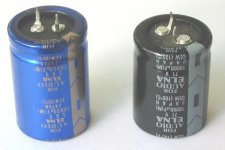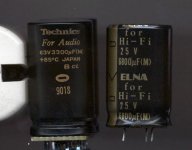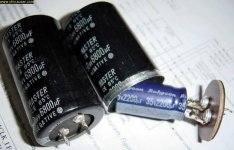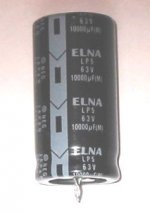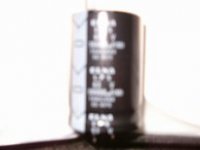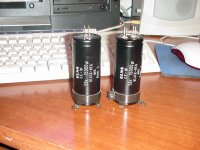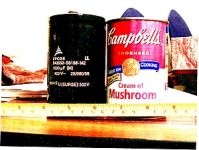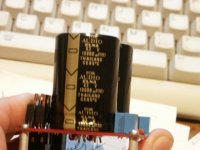Would anybody know if the black capacitor (10,000uF 71V ) capacitor is a fake ? The plastic is not even and the top cover is made of VERY thin plastic.
Can the 71V unit be smaller than the 56V type?
The Blue one looks 'neat' and I am inclined to think it is an original ( 10,000uF 56V).
Thanks,
Ashok.
Can the 71V unit be smaller than the 56V type?
The Blue one looks 'neat' and I am inclined to think it is an original ( 10,000uF 56V).
Thanks,
Ashok.
Attachments
May be both are fake
I have seen some similar with the black one, and they are fake. The blue one is quite similar with starget in color, but not in build quality.
IMHO, most fake components are very easy to determine from the build quality (the print), that is if you have seen the original one.
I've never found a fake component that is sold for original component's price. Original ELNA are expensive, especially when it is claimed for audio. This label itself ("For Audio") looks suspicious to me. It just seems not proffessional (Elna has starget, silmic, cerafine, etc, and Rubicon Black Gate has N, NX, Muse, etc, all with their own purpose in audio implementation).
I believe you got the blue one for less than half a Starget price. I have used cheap "branded" capacitors, and they sound horrible. Cheap but original Nippon-Chemicon is much better. I used Nippon-Chemicon (damn, I hope I'm not mistaken with the brand) for my power supplies. A lot cheaper than the Cerafine, but almost equal in quality (for power supply).
I said, for power supply caps, just go for the original one
I have seen some similar with the black one, and they are fake. The blue one is quite similar with starget in color, but not in build quality.
IMHO, most fake components are very easy to determine from the build quality (the print), that is if you have seen the original one.
I've never found a fake component that is sold for original component's price. Original ELNA are expensive, especially when it is claimed for audio. This label itself ("For Audio") looks suspicious to me. It just seems not proffessional (Elna has starget, silmic, cerafine, etc, and Rubicon Black Gate has N, NX, Muse, etc, all with their own purpose in audio implementation).
I believe you got the blue one for less than half a Starget price. I have used cheap "branded" capacitors, and they sound horrible. Cheap but original Nippon-Chemicon is much better. I used Nippon-Chemicon (damn, I hope I'm not mistaken with the brand) for my power supplies. A lot cheaper than the Cerafine, but almost equal in quality (for power supply).
I said, for power supply caps, just go for the original one
I don't know how common this is (one would hope this is an isolated case), but it just goes to show - take nothing for granted!
You can test cap. values with even cheap multimeters these days and checking manufacturers websites for pictures is, of course, always an option. Granted it shouldn't be the case that this should be necessary, but if you're ordering any quantity of large name-brand caps. it could cost quite a lot and testing a single unit may be prudent.
Also if you find a fraudulent retailer I'm sure the manufacturer of the original unit would appreciate being informed.
Hope this helps?
You can test cap. values with even cheap multimeters these days and checking manufacturers websites for pictures is, of course, always an option. Granted it shouldn't be the case that this should be necessary, but if you're ordering any quantity of large name-brand caps. it could cost quite a lot and testing a single unit may be prudent.
Also if you find a fraudulent retailer I'm sure the manufacturer of the original unit would appreciate being informed.
Hope this helps?
I found Elna datasheet for those caps. There is no 10000uF value for 71WV. But the datasheet may be old.
http://borc.sloweb.net/Elna LPO.pdf
http://borc.sloweb.net/Elna LPO.pdf
71V working voltage is not an unusual value, just like 56V an 80V (usually there's only 50V/63V/100V
The casing looks like the LP5-series (about a month or 2 I bought a box (100) of the LP5 10.000µF/63V capacitors.
They have a slightly different text, but same case-color, and printing type.
63V capacitors can work at 71V's. Maybe they used a "cheap" LP5 capacitor and just printed something else on it (71V and the text "for audio" just makes it a little more expensive).
Grtz, Joris
The casing looks like the LP5-series (about a month or 2 I bought a box (100) of the LP5 10.000µF/63V capacitors.
They have a slightly different text, but same case-color, and printing type.
63V capacitors can work at 71V's. Maybe they used a "cheap" LP5 capacitor and just printed something else on it (71V and the text "for audio" just makes it a little more expensive).
Grtz, Joris
Hi Joris,
I think Borc and I were trying to point out that Elna does not have a 10,000uF/71V capacitor in their range. Not even in their latest catalogue on the Web. No argument about other makes having 71V and 80 V in their range , Elna also but at lower capacitance values.
Does the Elna you bought look like the one in the picture?
Cheers,
Ashok.
I think Borc and I were trying to point out that Elna does not have a 10,000uF/71V capacitor in their range. Not even in their latest catalogue on the Web. No argument about other makes having 71V and 80 V in their range , Elna also but at lower capacitance values.
Does the Elna you bought look like the one in the picture?
Cheers,
Ashok.
Attachments
Fake Elna Elcos
Having worked for Rubycon for 10 years I have seen very many large Elcos with unusual voltages. Many Japanese manufacturers (JVC, Pioneer etc) ask for non-standard voltages to be supplied so 71V is not unusual. We have supplied panasonic with 5600mfd 72V. It is very difficult to identify "fake" capacitors. In the end the only way of detecting them is to measure cap, esr, Tan delta and leakage and compare with known good devices. If that does not confirm the "fake" cut the unit open. A good clue is how big is the wound unit they are usually designed to be a reasonably tight fit in the can.
Having worked for Rubycon for 10 years I have seen very many large Elcos with unusual voltages. Many Japanese manufacturers (JVC, Pioneer etc) ask for non-standard voltages to be supplied so 71V is not unusual. We have supplied panasonic with 5600mfd 72V. It is very difficult to identify "fake" capacitors. In the end the only way of detecting them is to measure cap, esr, Tan delta and leakage and compare with known good devices. If that does not confirm the "fake" cut the unit open. A good clue is how big is the wound unit they are usually designed to be a reasonably tight fit in the can.
Hi Ashok,
It looks pretty much like your picture but some small differences:
The text from top to bottom says (yeah, it's a REALLY nbad picture I made)
ELNA
LP 5
63 V
10000µF(M)
THAILAND
CE 85°C
(this text is printed 3 times on it)
The side where the lips are, is made of rubber I think.
Grtz, Joris
It looks pretty much like your picture but some small differences:
The text from top to bottom says (yeah, it's a REALLY nbad picture I made)
ELNA
LP 5
63 V
10000µF(M)
THAILAND
CE 85°C
(this text is printed 3 times on it)
The side where the lips are, is made of rubber I think.
Grtz, Joris
Attachments
Re: Fake Elna Elcos
I bought some BG F series caps recently (1000/35) , and it seems like not standard cap comparing to current BG line. Would you know anything about those?
It is the same size as 1000/50 STD, but has 3 pins.
kpee said:Having worked for Rubycon for 10 years
I bought some BG F series caps recently (1000/35) , and it seems like not standard cap comparing to current BG line. Would you know anything about those?
It is the same size as 1000/50 STD, but has 3 pins.
grataku said:Annex,
that's one instant classic! I m glad you posted it since I had missed it.
I bet whoever used them caps found prodigious improvement in the sound.
Kind of reminds me of some caps I bought awhile ago where, upon shaking, you could feel, and hear, stuff moving inside.

Sounds like they may be dodgy ones too.
It's worrying enough that the capacitance rating used on the inner cap. on the photo I posted was lower than that printed on the fake casing, but the safe working voltage is also lower - which could potentially lead to any number of dangerous situations, shorts, etc.
Another disturbing story I have heard told amongst the DiyAudio enthusiasts is that of fake transformers!
I believe it was posted that a large, "un-named" company sold power amplifiers using large transformers that appeared to be potted toroids - i.e. large, heavy and plastic coated. One DIYer in his wisdom/curiosity (??) decided that he would cut one of the transormers open only to find a small EI core transformer and a lot of sand!
Shocking!
It is the same size as 1000/50 STD, but has 3 pins.
Blackgates are a puzzle as Rubycon will not let them be sold outside japan and should have stopped suppling production quantities 2 or 3 years ago.
Rubycon is only making these under license and the case sizes and specifications are dependent on what is required by the OEM who originally ordered the item. So there are many variations of case size and pin out for the same capacitance and voltage rating
Blackgates are a puzzle as Rubycon will not let them be sold outside japan and should have stopped suppling production quantities 2 or 3 years ago.
Rubycon is only making these under license and the case sizes and specifications are dependent on what is required by the OEM who originally ordered the item. So there are many variations of case size and pin out for the same capacitance and voltage rating
This is not a fake
HI,
I have bought this from a surplus dealer. The famous Epcos cap.
Its dimensions are all the same as written in the official datasheet, but its weights 120g less. It 's like 250g rather than 420g. I charge it for a minute with 520vds which is 70vdc higher than its design. It is fine with that voltage. It's capacitance is also correct. If it is a fake, must be a very good one. Is there anybody knows a easy way to test ESR?
HI,
I have bought this from a surplus dealer. The famous Epcos cap.
Its dimensions are all the same as written in the official datasheet, but its weights 120g less. It 's like 250g rather than 420g. I charge it for a minute with 520vds which is 70vdc higher than its design. It is fine with that voltage. It's capacitance is also correct. If it is a fake, must be a very good one. Is there anybody knows a easy way to test ESR?
Attachments
Doh, I wish I had seen this thread before i bought these:
http://cgi.ebay.co.uk/ws/eBayISAPI.dll?ViewItem&item=230042394101
I hope they turn out to be real. I also didn't realise the seller was in china until I had already paid. I'll have to test the capacitance once they arrive I guess.
Also, are rubycons made in the USA? I thought they were made in Japan?
http://cgi.ebay.co.uk/ws/eBayISAPI.dll?ViewItem&item=230042394101
I hope they turn out to be real. I also didn't realise the seller was in china until I had already paid. I'll have to test the capacitance once they arrive I guess.
Also, are rubycons made in the USA? I thought they were made in Japan?
MikeHunt79 said:Doh, I wish I had seen this thread before i bought these:
http://cgi.ebay.co.uk/ws/eBayISAPI.dll?ViewItem&item=230042394101
I hope they turn out to be real. I also didn't realise the seller was in china until I had already paid. I'll have to test the capacitance once they arrive I guess.
Also, are rubycons made in the USA? I thought they were made in Japan?
I have bought GLCD 128x64 from that seller (Sure electronics) and SMD resistors, both items were ok.
Please keep us updated.
- Status
- This old topic is closed. If you want to reopen this topic, contact a moderator using the "Report Post" button.
- Home
- Design & Build
- Parts
- Fake ELNA capacitors ?
